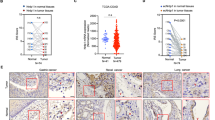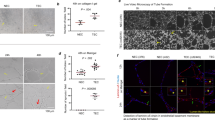Abstract
MULTIMERIN2 (MMRN2), also known as Endoglyx-1, is an extracellular matrix glycoprotein whose function has so far remained elusive. Given its specific localization in tight association with the endothelium we hypothesized that this protein could modulate neo-angiogenesis. By multiple assays we showed that MMRN2 significantly impaired endothelial cell (EC) migration and organization of a functional vessel network. The interaction of ECs with MMRN2 induced a striking impairment of VEGFR1 and VEGFR2 activation. We focused our attention on VEGFR2, a chief regulator of angiogenesis, and clarified that MMRN2 interfered with the VEGF/VEGFR2 axis through a direct binding with VEGF-A. This novel interaction was assessed in several assays and the affinity was estimated (Kd∼50 nM). We next questioned whether the anti-angiogenic properties of MMRN2 could impair tumor growth. Although overexpression of MMRN2 by HT1080 cells did not affect their growth and apoptotic rate in vitro, it remarkably affected their growth in vivo. In fact, MMRN2-positive cells failed to efficiently grow and form well-vascularized tumors; a similar outcome was observed following treatment of established tumors with a MMRN2 adenoviral construct. Tumor-section immunostaining revealed a strong co-localization of VEGF-A with the ectopically expressed MMRN2. These novel findings suggest that VEGF may be sequestered by MMRN2 and be less available for the engagement to the receptors. Taken together these results highlight MMRN2 as a crucial player in the regulation of EC function, neo-angiogenesis and hence tumor growth. We hypothesize that secreted and deposited MMRN2 may function as a homeostatic barrier halting the sprouting of novel vessels, and suggest that these studies may embody the potential for the development of novel tools for cancer treatment.
This is a preview of subscription content, access via your institution
Access options
Subscribe to this journal
Receive 50 print issues and online access
$259.00 per year
only $5.18 per issue
Buy this article
- Purchase on Springer Link
- Instant access to full article PDF
Prices may be subject to local taxes which are calculated during checkout






Similar content being viewed by others
References
Anghelina M, Krishnan P, Moldovan L, Moldovan NI . (2006). Monocytes/Macrophages cooperate with progenitor cells during neovascularization and tissue repair: conversion of cell columns into fibrovascular bundles. Am J Pathol 168: 529–541.
Aplin AC, Fogel E, Zorzi P, Nicosia RF . (2008). The aortic ring model of angiogenesis. Methods Enzymol 443: 119–136.
Boehm T, Folkman J, Browder T, O'Reilly MS . (1997). Antiangiogenic therapy of experimental cancer does not induce acquired drug resistance. Nature 390: 404–407.
Braghetta P, Ferrari A, De GP, Zanetti M, Volpin D, Bonaldo P et al. (2004). Overlapping, complementary and site-specific expression pattern of genes of the EMILIN/Multimerin family. Matrix Biol 22: 549–556.
Brekken RA, Huang X, King SW, Thorpe PE . (1998). Vascular endothelial growth factor as a marker of tumor endothelium. Cancer Res 58: 1952–1959.
Campbell NE, Kellenberger L, Greenaway J, Moorehead RA, Linnerth-Petrik NM, Petrik J . (2010). Extracellular matrix proteins and tumor angiogenesis. J Oncol 2010: 586905.
Carmeliet P . (2000). Mechanisms of angiogenesis and arteriogenesis. Nat Med 6: 389–395.
Chen TT, Luque A, Lee S, Anderson SM, Segura T, Iruela-Arispe ML . (2010). Anchorage of VEGF to the extracellular matrix conveys differential signaling responses to endothelial cells. J Cell Biol 188: 595–609.
Cheresh DA, Stupack DG . (2008). Regulation of angiogenesis: apoptotic cues from the ECM. Oncogene 27: 6285–6298.
Christian S, Ahorn H, Novatchkova M, Garin-Chesa P, Park JE, Weber G et al. (2001). Molecular cloning and characterization of EndoGlyx-1, an EMILIN-like multisubunit glycoprotein of vascular endothelium. J Biol Chem 276: 48588–48595.
de Vries C, Escobedo JA, Ueno H, Houck K, Ferrara N, Williams LT . (1992). The fms-like tyrosine kinase, a receptor for vascular endothelial growth factor. Science 255: 989–991.
Ferrara N . (2002). Role of vascular endothelial growth factor in physiologic and pathologic angiogenesis: therapeutic implications. Semin Oncol 29: 10–14.
Folkman J . (1971). Tumor angiogenesis: therapeutic implications. N Engl J Med 285: 1182–1186.
Gengrinovitch S, Berman B, David G, Witte L, Neufeld G, Ron D . (1999). Glypican-1 is a VEGF165 binding proteoglycan that acts as an extracellular chaperone for VEGF165. J Biol Chem 274: 10816–10822.
Greenaway J, Lawler J, Moorehead R, Bornstein P, Lamarre J, Petrik J . (2007). Thrombospondin-1 inhibits VEGF levels in the ovary directly by binding and internalization via the low density lipoprotein receptor-related protein-1 (LRP-1). J Cell Physiol 210: 807–818.
Hirama M, Takahashi F, Takahashi K, Akutagawa S, Shimizu K, Soma S et al. (2003). Osteopontin overproduced by tumor cells acts as a potent angiogenic factor contributing to tumor growth. Cancer Letters 198: 107–117.
Holmqvist K, Cross MJ, Rolny C, Hagerkvist R, Rahimi N, Matsumoto T et al. (2004). The adaptor protein shb binds to tyrosine 1175 in vascular endothelial growth factor (VEGF) receptor-2 and regulates VEGF-dependent cellular migration. J Biol Chem 279: 22267–22275.
Hotz B, Backer MV, Backer JM, Buhr HJ, Hotz HG . (2010). Specific targeting of tumor endothelial cells by a shiga-like toxin-vascular endothelial growth factor fusion protein as a novel treatment strategy for pancreatic cancer. Neoplasia 12: 797–806.
Hu M, Polyak K . (2008). Microenvironmental regulation of cancer development. Curr Opin Genet Dev 18: 27–34.
Huber MA, Kraut N, Schweifer N, Dolznig H, Peter RU, Schubert RD et al. (2006). Expression of stromal cell markers in distinct compartments of human skin cancers. J Cutan Pathol 33: 145–155.
Hutchings H, Ortega N, Plouet J . (2003). Extracellular matrix-bound vascular endothelial growth factor promotes endothelial cell adhesion, migration, and survival through integrin ligation. FASEB J 17: 1520–1522.
Jaffe EA, Nachman RL, Becker CG, Minick CR . (1973). Culture of human endothelial cells derived from umbilical veins. Identification by morphologic and immunologic criteria. J Clin Invest 52: 2745–2756.
Joyce JA, Pollard JW . (2009). Microenvironmental regulation of metastasis. Nat Rev Cancer 9: 239–252.
Koperek O, Scheuba C, Puri C, Birner P, Haslinger C, Rettig W et al. (2007). Molecular characterization of the desmoplastic tumor stroma in medullary thyroid carcinoma. Int J Oncol 31: 59–67.
Kupprion C, Motamed K, Sage EH . (1998). SPARC (BM-40, osteonectin) inhibits the mitogenic effect of vascular endothelial growth factor on microvascular endothelial cells. J Biol Chem 273: 29635–29640.
Lawler J . (2002). Thrombospondin-1 as an endogenous inhibitor of angiogenesis and tumor growth. J Cell Mol Med 6: 1–12.
Ligresti G, Aplin AC, Zorzi P, Morishita A, Nicosia RF . (2011). Macrophage-derived tumor necrosis factor-a is an early component of the molecular cascade leading to angiogenesis in response to aortic injury. Arterioscler Thromb Vasc Biol 31: 1151–1159.
Mongiat M, Marastoni S, Ligresti G, Lorenzon E, Schiappacassi M, Perris R et al. (2010). The extracellular matrix glycoprotein elastin microfibril interface located protein 2: a dual role in the tumor microenvironment. Neoplasia 12: 294–304.
Mongiat M, Sweeney SM, San Antonio JD, Fu J, Iozzo RV . (2003). Endorepellin, a novel inhibitor of angiogenesis derived from the C terminus of perlecan. J Biol Chem 278: 4238–4249.
Mustonen T, Alitalo K . (1995). Endothelial receptor tyrosine kinases involved in angiogenesis. J Cell Biol 129: 895–898.
Nicosia R . (2009). The aortic ring model of angiogenesis: a quarter century of search and discovery. J Cell Mol Med. 13: 4113–4136.
Nyberg P, Salo T, Kalluri R . (2008). Tumor microenvironment and angiogenesis. Front Biosci 13: 6537–6553.
Olsson AK, Dimberg A, Kreuger J, Claesson-Welsh L . (2006). VEGF receptor signalling—in control of vascular function. Nat Rev Mol Cell Biol 7: 359–371.
Roccaro AM, Hideshima T, Raje N, Kumar S, Ishitsuka K, Yasui H et al. (2006). Bortezomib mediates antiangiogenesis in multiple myeloma via direct and indirect effects on endothelial cells. Cancer Res 66: 184–191.
Sahni A, Francis CW . (2000). Vascular endothelial growth factor binds to fibrinogen and fibrin and stimulates endothelial cell proliferation. Blood 96: 3772–3778.
Sanz-Moncasi MP, Garin-Chesa P, Stockert E, Jaffe EA, Old LJ, Rettig WJ . (1994). Identification of a high molecular weight endothelial cell surface glycoprotein, endoGlyx-1, in normal and tumor blood vessels. Lab Invest 71: 366–373.
Spessotto P, Giacomello E, Perris R . (2000). Fluorescence assays to study cell adhesion and migration in vitro. Methods Mol Biol 139: 321–343.
Sun J, Hopkins BD, Tsujikawa K, Perruzzi C, Adini I, Swerlick R et al. (2009). Thrombospondin-1 modulates VEGF-A-mediated Akt signaling and capillary survival in the developing retina. Am J Physiol Heart Circ Physiol 296: H1344–H1351.
Terman BI, Dougher-Vermazen M, Carrion ME, Dimitrov D, Armellino DC, Gospodarowicz D et al. (1992). Identification of the KDR tyrosine kinase as a receptor for vascular endothelial cell growth factor. Biochem Biophys Res Commun 187: 1579–1586.
Ventura E, Sassi F, Parodi A, Balza E, Borsi L, Castellani P et al. (2010). Alternative splicing of the angiogenesis associated extra-domain B of fibronectin regulates the accessibility of the B-C loop of the type III repeat 8. PLoS One 5: e9145.
Waltenberger J, Claesson-Welsh L, Siegbahn A, Shibuya M, Heldin CH . (1994). Different signal transduction properties of KDR and Flt1, two receptors for vascular endothelial growth factor. J Biol Chem 269: 26988–26995.
Wijelath ES, Murray J, Rahman S, Patel Y, Ishida A, Strand K et al. (2002). Novel vascular endothelial growth factor binding domains of fibronectin enhance vascular endothelial growth factor biological activity. Circ Res 91: 25–31.
Zoeller JJ, Whitelock JM, Iozzo RV . (2009). Perlecan regulates developmental angiogenesis by modulating the VEGF-VEGFR2 axis. Matrix Biol 28: 284–291.
Acknowledgements
We thank Dr Philip Thorpe and Dr Rolf Brekken for the generous gift of the Gv39M antibody. We thank the ISS-ACC Program 2, AIRC and MIUR (grant no.RBRN07BMCT) for supporting this work.
Author information
Authors and Affiliations
Corresponding authors
Ethics declarations
Competing interests
The authors declare no conflict of interest.
Additional information
Supplementary Information accompanies the paper on the Oncogene website (
Rights and permissions
About this article
Cite this article
Lorenzon, E., Colladel, R., Andreuzzi, E. et al. MULTIMERIN2 impairs tumor angiogenesis and growth by interfering with VEGF-A/VEGFR2 pathway. Oncogene 31, 3136–3147 (2012). https://doi.org/10.1038/onc.2011.487
Received:
Revised:
Accepted:
Published:
Issue Date:
DOI: https://doi.org/10.1038/onc.2011.487
Keywords
This article is cited by
-
Group XIV C-type lectins: emerging targets in tumor angiogenesis
Angiogenesis (2024)
-
Angiogenesis modulated by CD93 and its natural ligands IGFBP7 and MMRN2: a new target to facilitate solid tumor therapy by vasculature normalization
Cancer Cell International (2023)
-
Extracellular matrix remodeling in tumor progression and immune escape: from mechanisms to treatments
Molecular Cancer (2023)
-
Proteomic profiling of concurrently isolated primary microvascular endothelial cells, pericytes, and vascular smooth muscle cells from adult mouse heart
Scientific Reports (2022)
-
Colorectal cancer development is affected by the ECM molecule EMILIN-2 hinging on macrophage polarization via the TLR-4/MyD88 pathway
Journal of Experimental & Clinical Cancer Research (2022)



